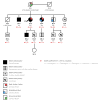Familial Dilated Cardiomyopathy and Sudden Cardiac Arrest: New Association with a SCN5A Mutation
- PMID: 34946838
- PMCID: PMC8701882
- DOI: 10.3390/genes12121889
Familial Dilated Cardiomyopathy and Sudden Cardiac Arrest: New Association with a SCN5A Mutation
Abstract
Dilated cardiomyopathy (DCM) has significant morbidity and mortality. Familial transmission is reported in 20-35% of cases, highlighting the role of genetics in this disorder. We present an interesting family in which the index case is a 64-year-old woman who survived a sudden cardiac arrest. She presented left ventricular dilatation and dysfunction, which indicated the presence of DCM, as well as a history of DCM and sudden arrest in her family (mother and sister). Genetic testing identified a heterozygous mutation c.74A > G missense change that causes an amino acid, p.Glu25Gly, change in the N-terminal domain of the SCN5A protein. After performing an exhaustive family medical history, we found that this previously not described mutation segregated within the family. All relatives with the DCM phenotype were carriers, whereas none of the noncarriers showed signs of heart disease, so this mutation is the most likely cause of the disease. This is the first time that a variant in the N-terminal domain of SCN5A has been associated with DCM.
Keywords: SCN5A; dilated cardiomyopathy; familial dilated cardiomyopathy; genetic study; novel mutation.
Conflict of interest statement
The authors declare no conflict of interest.
Figures



References
-
- Gaertner A., Bloebaum J., Brodehl A., Klauke B., Sielemann K., Kassner A., Fox H., Morshuis M., Tiesmeier J., Schulz U., et al. The Combined Human Genotype of Truncating TTN and RBM20 Mutations Is Associated with Severe and Early Onset of Dilated Cardiomyopathy. Genes. 2021;12:883. doi: 10.3390/genes12060883. - DOI - PMC - PubMed
Publication types
MeSH terms
Substances
Supplementary concepts
LinkOut - more resources
Full Text Sources
Miscellaneous

